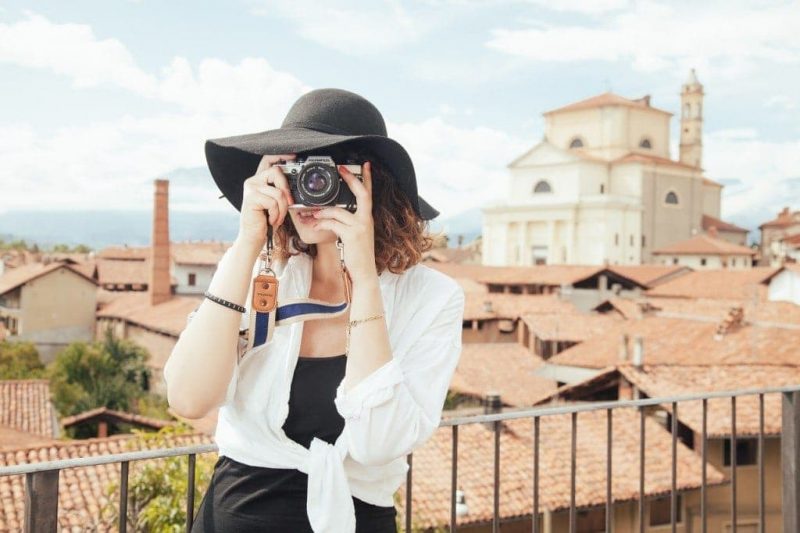Some posts on this site contain affiliate links. If you book or buy something through these links, I earn a small commission (at no extra cost to you). Take a look at my privacy policy for more information.

Solo photography, as a travel photography subgenre, preserves memories, encapsulates your adventures, and enables you to share your story with the world without relying on a third party. However, being both in front and behind the camera is not easy. This task can be daunting even for advanced photographers who know how to take travel photos.
This guide offers photography tips for solo travellers, ensuring every snapshot tells a story of the unique travel experience. Explore innovative methods and tools to become your own photographer. Let no mesmerizing moment go uncaptured.
Basics of Solo Photography
The essential step in taking captivating photos is selecting the best camera for solo travel. A camera with a reliable timer, a high-quality front-facing screen for framing, and robust image stabilization can transform your solo photography experience. You need gear that will serve as an extension of your vision. The perfect camera should intuitively capture the essence of your journey without requiring an extra pair of hands.
Once you have found your ideal equipment, it is time to master the two paramount aspects of photography: composition and lighting. Studying the basic rules of composition will help you place your subject so that it will easily catch the viewers’ eye.
Lighting can alter the mood of your images. Travel photography (and solo travel photography as a part of it) is a genre where the lighting conditions cannot be fully controlled. Studio conditions are not an option in this case, so you need to adjust to the lighting you have (natural or artificial) and make it work for you. Do not be upset if you cannot achieve the desired results because of the lighting conditions. There is always a chance to save an “unsuccessful” photo with post-processing tools, such as a picture brightener.
For solo travelers, the art of taking a great photo also involves a bit of creativity and experimentation. Using natural elements like reflections in water, mirrors, or even shadows can add depth and interest to your photos. Learning to play with angles and perspectives by placing your camera on the ground or shooting from a high vantage point can make your pictures more dynamic and captivating.
A solo travel photographer plays two roles simultaneously — a photographer and a model. So, finding a perfect angle and taming the light is unlikely to result in a good picture if you do not feel confident in front of the camera. Set up your shot and use a remote shutter or a camera timer. It will give you time to enter the frame naturally.
Advanced Techniques for Solo Photographers
Long Exposure
Whether it is the smooth flow of a waterfall, the bustling lights of a city at night, or the serene motion of clouds across a mountain range, long exposure is pivotal for capturing the beauty of the world in movement. This technique requires a camera with manual settings and a sturdy tripod to ensure image stability. Ensure the pictures will be perfectly focused without the unnecessary blur, even if you keep the shutter open for a long time.
HDR
Pictures of the same scene with different exposures help balance lights and shadows. High-contrast situations like sunrise and sunset require the high dynamic range technique. The difference in light levels between the sky and the ground can be challenging to capture in a single shot. Most modern cameras and smartphones offer an HDR mode. However, manually blending photos in post-processing software is a better option for more control and professional results.
Panoramic Shots
Solo travelers often find themselves in awe-inspiring locations hard to capture in a single frame. Panoramic photography allows you to stitch multiple shots into a wide or 360-degree view. This technique is perfect for capturing landscapes or cityscapes. Many cameras and phones have a panoramic function. However, taking individual photos with overlapping edges and using photo editors to stitch them together can yield higher-quality panoramas.
Creative Use of Focus
Experiment with the depth of the field to isolate your subject from the background. Draw the viewer’s eye directly to the intended focal point. It will add an emotional layer to your shot. A shallow depth of field is used for a softer background. It leads to the main subject standing out sharply. This technique is particularly effective for highlighting intricate details, like the texture of a leaf, the pattern on a building, or the emotion on a person’s face. Conversely, a deep depth of field, using a smaller aperture, keeps both the foreground and background in sharp focus, which is ideal for capturing landscapes and cityscapes.
Visual Storytelling
Each photo should convey a piece of your journey, encapsulating the emotions, cultures, and experiences you encounter. Think of your photos as chapters in a larger narrative of your travels. This approach might include capturing the intricate details of a local market, the expressions of people you meet, or the tranquility of a secluded spot you stumbled upon. Keep your eyes open to catch fleeting moments.
Conclusion
In the given article, we delved into the equipment that can elevate your solo photography, offered advanced tips for refining your shots, and discussed how to capture your adventures effectively. Whether you are a seasoned photographer or a novice eager to document your travels, these insights will empower you to take stunning photos you will treasure for a lifetime.


